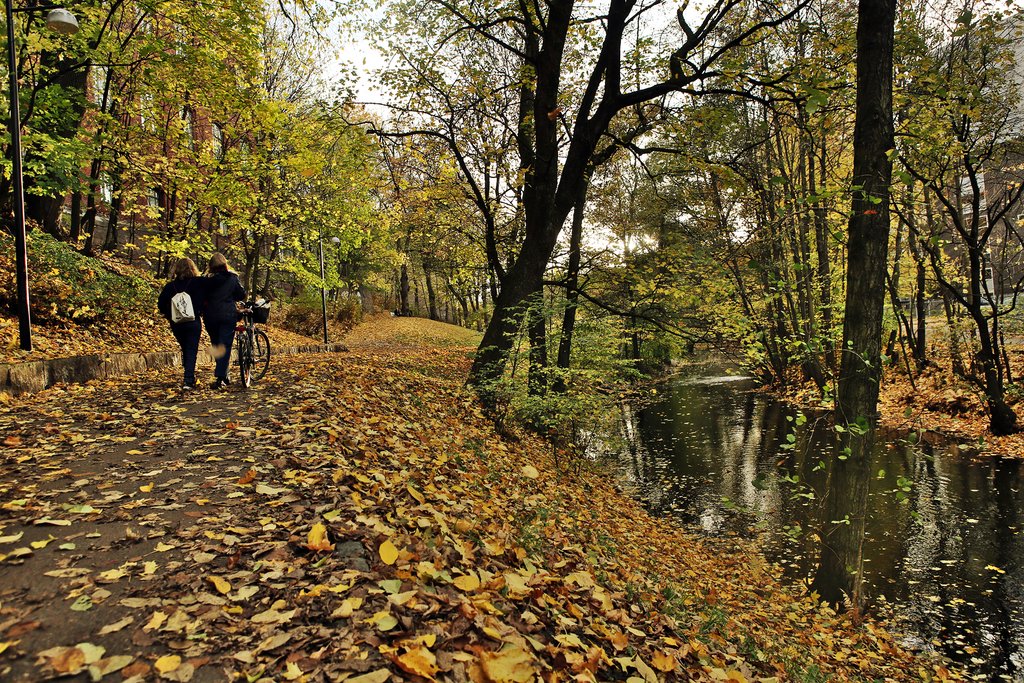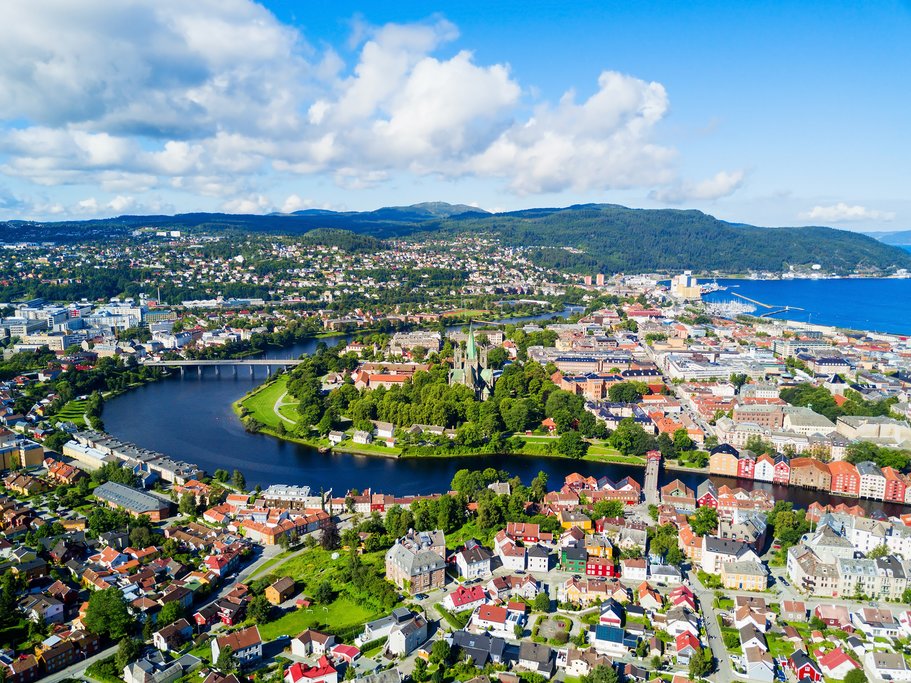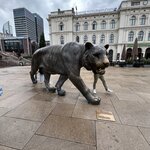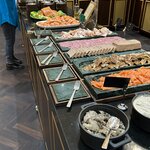Highlights
- Walk, jog, or bike along Oslo's new five-and-a-half-mile waterfront park
- Get up close to Europe's largest mainland glacier
- Have lunch in Geiranger overlooking a beautiful UNESCO-listed fjord
- Climb up Ålesund's Sugar Top Hill for excellent views of the city, fjord, and coast
- Explore Norway's third largest city by renting one of the red-painted bicycles
Brief Itinerary
| Day | Highlights | Overnight |
|---|---|---|
| Day 1 | Arrive in Oslo | Oslo |
| Day 2 | Explore Oslo's hidden gems with a local expert | Oslo |
| Day 3 | Explore Oslo's Nature Trails | Oslo |
| Day 4 | Train to Flåm - Fjordcruise to Bergen | Bergen |
| Day 5 | Explore Bergen with a Local | Bergen |
| Day 6 | Bergen - Drive to Fjærland | Fjærland |
| Day 7 | Visit Jostedalsbreen Glacier - Drive to Geiranger | Geiranger |
| Day 8 | Explore Geiranger - Drive to Ålesund | Ålesund |
| Day 9 | Drive to Kristiansund via the Atlantic Road | Kristiansund |
| Day 10 | Kristiansund - Drive to Trondheim | Trondheim |
| Day 11 | Trondheim - Drive to Oslo | Oslo |
| Day 12 | Depart Oslo |
Detailed Itinerary
Day 1: Arrive in Oslo

Welcome to Oslo! Norway's rapidly growing capital is still considered a small city, helped by the fact that it's surrounded by mountains and sea. Not only is the city center made for walking, but outlying neighborhoods—filled with charm and character—are easily accessible by public transportation, so jump on a tram, train, or bus and explore all of what Oslo has to offer.
Suggested activities include:
- Take a half-day and wander around Aker Brygge, an area on the Oslofjord made up of beautiful, modern buildings where you can find bars and abundant nightlife. It acts as a sort of courtyard for the city of Oslo and brings together both tourists and locals alike to enjoy the great food, atmosphere, and entertainment.
- Spend the afternoon visiting the Viking Ship Museum and the Norwegian Open-Air Folk Museum by way of public transportation. Both museums are in the same area, so they pair well together!
- Walk along the Havnepromenaden (harbor promenade)—a new five-and-a-half-mile waterfront park, which combines sightseeing, history, art, architecture, and a little bit of adventure.
- Visit the Vigeland Sculpture Park, where 200 larger than life sculptures are placed throughout this green lung in the middle of the city.
For dinner, explore the city's historic core buzzing with restaurants and cafés that stay cozy in cold weather, with several options that offer outdoor seating during summer months.
Day 2: Explore Oslo's hidden gems with a local expert

After breakfast, get ready to meet your local expert. He/she will show you Oslo from a local's perspective. Get the trip tailored to your interest or surrender into the hands of your local expert and be surprised! Taste the real Oslo from a walk in Damstredet and its beautiful small street with wooden houses from the 1800's to the urban Grünerløkka via the vibrant food court Mathallen. A walk along the Akerselva River should not be missed as it is a central part of the history of Oslo!
Make sure to get recommendations of your interests from your expert and indulge in the local expertise.
The opportunities for experiencing culture in this amazing city are endless! Oslo is located between the water and evergreen forests — and though it's the capital of Norway, it only takes 30 minutes to travel from one end to the other by metro. Oslo is known for its museums, some of which celebrate the famous works of Edvard Munch or the stunning ships of the Viking Era, while others celebrate niche interests such as music and ski history.
The city also has a popular café culture, with locals and visitors enjoying some of the best coffee in the world. In warmer weather, there's nothing like sitting outside on the patio with coffee and a pastry or sandwich on freshly baked Norwegian bread. On chilly days, stepping into one of Oslo's local cafes will make you feel cozy and warm.
Enjoy Oslo!
Day 3: Explore Oslo's Nature Trails

Today is a free day to explore Olso any way you'd like! If you've had enough urban culture and want to get some fresh air, you can use this time to take a long walk along the River Akerselva.
If you've already done that, a great day trip is to head outside of the city for a longer hike through Europe's largest urban forest, called Nordmarka, taking in a variety of sites ranging from traditional wooden buildings, hilltop viewpoints, pristine lakes, and possibly fresh berries!
Check out the well-marked area on your own (trail maps are available) or join a guided hiking tour where you'll be led through dirt paths, rocky passages, and deep forests as you make your way to the viewpoint of Vettakollen—a locals' only destination for one of the best views in all of Oslo. This stop is perfect for a panoramic lunch (bring your own or purchase along the way at a café in a local forest cabin).
After lunch, continue through the forest until you get to the shores of Sognsvann, one of Oslo's prettiest lakes—great for a swim if the weather permits. The tour ends here, with easy access to a metro stop for your return to Oslo's city center where you'll have the rest of the evening to enjoy at leisure.
Chat with a local specialist who can help organize your trip.
Day 4: Train to Flåm - Fjordcruise to Bergen

This morning, after an early breakfast at your hotel, you'll take the train to Myrdal and then connect to the famous Flåm Railway. This is known as one of the steepest railways in the world, with spectacular views of mountainous peaks and fjords. Be sure to watch for the Kjosfossen waterfall (the train will stop here for photographs before departing again for Flåm.)
Once you arrive, you may have some time to explore this small village along the Sognefjord. You may want to set out on a nearby hiking trail, visit the Flam Railway Museum, or tour the Flåm church—constructed from wood in 1667. Be sure to sample traditional Norwegian cuisine at one of the many cafes, pubs or restaurants in town.
In the mid-afternoon, you'll head to Flåm's port to travel to Bergen by ferry (about five hours) along the Sognefjord. Enjoy spectacular scenery and refreshments as you set sail and learn about local villages along this route. For instance, you'll cruise along the spectacular Aurlandsfjord, a branch of the Sognefjord which flows through Aurland and Undredal for your viewing pleasure. You'll also have an opportunity to gawk at the UNESCO World Heritage-listed Nærøyfjord with towering mountains rising 5,600 feet (1,700 m) high.
Once you get to Bergen, check out the Bryggen area of downtown to view old wooden houses dating back to the 1700s (a protected UNESCO World Heritage Site). The cobblestoned streets in town are compact and walkable, with lively restaurants and nightlife, thanks in part to a young student population.
Day 5: Explore Bergen with a Local

After breakfast at your hotel, meet up with a local resident for a custom private tour of Bergen. Your guide, who was born and raised in Bergen, will find the right tour for you based on your interests. Here are a few walk or hike ideas that past travelers have enjoyed:
- Walk through History (3 hours): This walk starts from the city center and travels through narrow streets up to the mountainside known as “Sandviksbatteriet” with spectacular views over the city. From here, the trail takes you to a small, hidden cabin rich in World War II history. During the walk, your local guide will offer local stories of Bergen's history and culture.
- Explore Bergen's Parks & Architecture (3 hours): This easy walking tour visits notable exteriors and city parks starting with the largest church in Bergen: St. Johannes. From there, you will walk through the botanic garden and onwards to Bergen`s largest and most beautiful park: Nygårdsparken. You'll then walk through the city's narrow streets lined with traditional Bryggen houses and eventually visit Nordnes, another great park. Your guide will share stories of life in Bergen, as well as offer lesser-known activity and restaurant recommendations not frequented by tourists.
- Hike Mt. Sandviken (2.5 hours): This hike heads to Mt. Sandviken, one of the seven mountains surrounding Bergen, including a visit to Stoltzekliven—a local favorite consisting of 900 steps built by sherpas from Nepal. This trail is home to the steepest race in the world and features spectacular views from the top!
The rest of the day is yours to continue exploring the city on your own. If you get a 24-Hour Bergen Card, that will allow you free bus travel and free admittance to most museums (as well as other attractions), so take advantage!
Day 6: Bergen - Drive to Fjærland

This morning you'll have time to enjoy more of Bergen before picking up your rental car. From here, you'll make your way to Fjærland—a drive that takes 170 miles (274 km), or about 4.5 hours. Keep in mind that this route includes a pay-on the-spot ferry between Oppedal and Lavik (35 minutes).
Once you arrive in the Fjærland area, get out and explore your surroundings. The small village is situated along the Sognefjord and has the glacier Jostedalsbreen, the largest mainland glacier in Europe, as its nearest neighbor. To give you a sense of the coziness here, there are only 300 residents in Fjærland.
A good place to start is heading to the town's waterfront where you can take in views of the Fjærlandsfjord. You can also head for Fjærland's village center, called Mundal, and visit the Norwegian Booktown, which consists of several second-hand bookshops, some combined with cafés, art galleries, and souvenir shops located in farmhouses and sheds. It's also worth visiting Hotel Mundal—an elegant wooden hotel from 1891.
Also not to miss (either today or tomorrow) is the Norwegian Glacier Museum, an award-winning architectural marvel situated at the head of the Fjærlandsfjord. This hands-on museum is the leading center in Norway for knowledge regarding glaciers and climate change.
Day 7: Visit Jostedalsbreen Glacier - Drive to Geiranger

Today, you'll head to Jostdalsbreen National Park, the largest glacier in Norway (and mainland Europe), with several glacial arms to explore.
Almost half of the Jostedalsbreen National Park is covered by the Jostedalsbreen glacier, which is the largest glacier in mainland Europe. The national park is famous for its wide variety of natural environments all within a short distance of each other. These range from valleys with lush vegetation to bare mountains and glacier landscapes. There are several hiking trails and opportunities to rent kayaks in a glacier lake.
From the national park, you'll take a two-hour drive along the scenic Geirangerfjord to the village of Geiranger, which takes 61 miles (98 km).
Day 8: Explore Geiranger - Drive to Ålesund

Today, you'll wake up in beautiful Geiranger and have time to explore the town by foot. Here you can experience open-air restaurants and sidewalk cafés, as well as shops and galleries for souvenirs. The town's restaurants and eateries take pride in creating fresh food with a local twist, like Geiranger Brewery partly located in a boathouse so you can enjoy more of those views.
From here, you'll drive from Geiranger to Ålesund via Trollstigen, a slow, mountainous route of 67 miles (108 km), so you'll have plenty of time to enjoy your surrounding fjords with plenty of photography breaks.
Once you reach Ålesund, you'll quickly find that this is one of the prettiest and most charming cities in Scandinavia with a breathtaking location stretching out into the Atlantic Ocean. The heavy presence of Art Nouveau architecture is a result of rebuilding efforts following a devastating fire in 1904.
The city is the cultural center of the region with an array of museums, a sea park, a lighthouse (Alnes), and charming streets to explore on foot, not to mention numerous outdoor activities such as hiking and stand-up paddle boarding.
For a hearty and authentic Norwegian dinner, consider dinner at Café Lyspunktet—also a place to come for great coffee, live music, and local art exhibitions.
Day 9: Drive to Kristiansund via the Atlantic Road

This morning, you'll have time to enjoy breakfast and walk around Ålesund before driving to Kristiansund—home of the bacalao delicacy, made from Norwegian Cod and produced in this area for over 500 years! This 96-mile (154 km) drive includes a ferry between Molde to Vestnes, where you'll pay on the spot.
Kristiansund is an interesting hub consisting of four main islands, as well as a number of smaller ones. In fact, it is one of the most densely populated areas in Norway. Have a stroll around town, and if there's time, pay a visit to the Bacalao Museum and the Grip Stave Church before finding a spot for dinner.
Day 10: Kristiansund - Drive to Trondheim

After you refuel with breakfast at your hotel, you'll get back on the road for your drive to Trondheim, which is 123 miles (197 km). This drive will include a ferry between Halsa and Kanestraum, and you'll pay on the spot.
Trondheim is a scenic city with beautiful parks and cultural sights, including the slightly out-of-kilter antique wooden houses. Walk across the historic Old Town Bridge—a 17th-century iron structure—for photographs. Visit the impressive Nidarosdomen Cathedral, built over the grave of St. Olav, the King of Norway in the 11th century. Head to popular museums including the National Museum of Decorative Arts, the Trondheim Museum of Art, the Archbishop’s Palace Museum, and the Rockheim, Norway’s national museum of popular music.
The intimate city center is also great for shopping with independent boutiques, along with local dining establishments, including pubs, cafés, and restaurants—many that serve locally-brewed beer.
Day 11: Trondheim - Drive to Oslo

After breakfast, you'll have time to explore more of Trondheim by foot, or by renting one of the red-painted bicycles at bike racks scattered around the city. Then, it's time to head back to Oslo. The drive will take 307 miles (6-7 hours) but you will pass beautiful scenery along the way
When you arrive, take advantage of anything you may have missed in Oslo at the beginning of the trip. Perhaps you'd like to head back to the waterfront and historic core for dinner. If you've already done this and want to try something new, head to the up-and-coming "Løkka" neighborhood and check out a slew of hip restaurants and bars.
During summer months, the city comes alive to celebrate extended daylight hours, with various festivals and celebrations happening each week, so keep your eyes and ears open.
Day 12: Depart Oslo

It's time to say farewell to Norway! Enjoy your last few hours walking around Oslo's neighborhoods, relaxing in a café, or visiting local boutiques for one-of-a-kind souvenirs.




